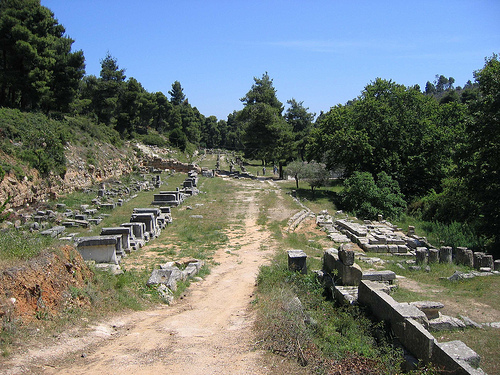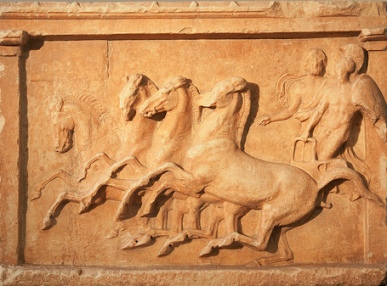

Location: Kalamos, Attica Map
Tel. 22960 22426
Open: daily
Closed: public holidays

The Oropos Archaeological Site, more precisely known as the Amphiareion of Oropos (or Amphiaraion), is an ancient Greek sanctuary dedicated to the hero and seer Amphiaraos, renowned for its oracular and healing functions. Located in a verdant ravine in East Attica, Greece, this site served as a pilgrimage destination from the late 5th century BCE through the Roman period, attracting visitors seeking dream-based prophecies and cures for ailments. Spanning approximately 240 meters along a streambed, the sanctuary features well-preserved ruins including a temple, theater, stoa, sacred spring, and a rare ancient water clock (clepsydra). It exemplifies classical Greek architecture and religious practices, with elements like incubation rituals (sleeping to receive divine dreams) linking it to broader healing cults, such as that of Asclepius. Though less famous than sites like Delphi, it offers a serene, less crowded experience amid pine forests, highlighting the blend of mythology, medicine, and athletics in ancient Greek culture. Visitor ratings average 4.7 out of 5 on platforms like Tripadvisor, based on about 38 reviews, with praise for its peaceful atmosphere and historical depth, though some note limited on-site information.
The site's origins tie to the mythology of Amphiaraos, a descendant
of the seer Melampos and a king who reluctantly joined the doomed Seven
Against Thebes expedition. Foreseeing disaster, he attempted to flee but
was swallowed by the earth (opened by Zeus's thunderbolt), transforming
him into a chthonic hero and god associated with prophecy and healing.
Oropos itself was founded by Euboean colonists in the 8th century BCE,
strategically positioned on the Attica-Boeotia border, leading to
frequent control shifts between Athens and Thebes. The sanctuary emerged
in the late 5th century BCE, gaining prominence during Athens' plague
(late 5th century BCE) as a healing center. It flourished in the 4th
century BCE with major constructions, including after Alexander the
Great's destruction of Thebes in 335 BCE, when Athens gained permanent
control.
The cult was both public and private, involving annual
festivals and the penteteric Greater Amphiareia with athletic games
(evidenced by late 5th-early 4th century BCE reliefs and a pre-338 BCE
victor catalogue). Pilgrims paid with lead tickets, abstained from food
and wine, sacrificed rams, and slept on their fleeces for dream
revelations—practices akin to incubation at other oracular sites.
Dedications came from Greeks, Romans (including notable figures), and
others, inscribed on bases. The site hosted events like gymnastics in a
stadion (location unknown) and remained active until Emperor Theodosius
I's decrees outlawed pagan worship in the late 4th century CE. In 414
BCE, Aristophanes produced a comedy titled Amphiaraos. Excavations
occurred from 1884 to 1929, revealing key structures, with artifacts now
in museums worldwide.
Nestled in a shallow, forested ravine between two hills at an
elevation of about 154 meters, the Amphiareion lies 6 km southeast of
the ancient port of Oropos (near modern Markopoulo Oropou), 37 km NNE of
Athens, in the Oropos municipality of East Attica. Coordinates are
approximately 38°18′N 23°48′E. The site's gentle northeast slope follows
a streambed, with the northwest bank hosting main structures and the
southeast side featuring domestic buildings and the clepsydra. Its
border location made it a contested cultural hub, while the sacred
spring's reputed healing waters drew pilgrims.
Key structures
include:
Temple of Amphiaraos: Early 4th century BCE Doric
hexastyle in antis (14 x 28 m), with six front columns between antae
(giving an octastyle facade). The cella had two rows of five internal
columns and housed an acrolithic cult statue (one arm in situ). An axial
altar northeast of the temple lists gods and heroes in five groups,
including Zeus, Apollo Paian, Heracles, Aphrodite, and river deities. A
stepped area around the altar may have been an early theatral space.
Theater: 2nd century BCE, seating ~300 with wooden benches on stone
supports. The 12.4 m radius orchestra is flanked by parodoi; the Doric
proscaenium (12 m wide) is well-preserved. Five marble prohedria (honor
seats) bear 1st century CE inscriptions from priest Nikon.
Stoa:
Mid-4th century BCE, 11 x 110 m, with 39 exterior Doric and 17 internal
Ionic columns. Stone benches lined the walls for pilgrims' incubation
sleeps.
Sacred Spring and Baths: The spring, east of the altar,
received coins from healed visitors. Nearby "men's" and "women's" baths
(possibly segregated) were famed in antiquity.
Clepsydra (Water
Clock): 4th century BCE, opposite the spring; a 2 m high reservoir with
a bronze outflow valve and calibrated scale for timekeeping,
compensating for pressure changes via sloping walls. Similar to one in
Athens' agora.
Other Features: 70 m line of statuary dedication bases
(many Roman-era); small southwest temple; domestic structures; possible
stadion and hippodrome (unlocated); 11-room pilgrim hostel.
The
site's layout integrates nature and architecture, with ruins amid pine
trees and a stream, evoking ancient tranquility.
As an open-air archaeological site, exhibits are the in-situ ruins themselves, with informational panels (though some visitors wish for more detail). The sanctuary's design reflects its dual role in healing and oracles: the stoa for dream incubation, spring for purification, and theater/stadion for festivals. Compared to Asclepieia (e.g., Epidauros), it emphasizes dream oracles over medical procedures, with Amphiaraos as a chthonic healer. Unique elements include the clepsydra's technological sophistication and the altar's multi-deity inscriptions, showing syncretic worship. Summer hosts ancient Greek plays in the theater, enhancing cultural immersion.
While many artifacts are in museums (e.g., a 4th century BCE chariot
race relief in Berlin's Pergamon Museum), on-site highlights include:
Fragmentary arm of Amphiaraos' acrolithic statue in the temple.
Five inscribed prohedria in the theater.
Dedication bases with Roman
inscriptions (e.g., from Flavius Xenion, consul suffectus in 100 CE).
Bronze clepsydra valve.
Inscribed sacred laws (4th century BCE) on
rituals.
Coins from the sacred spring, evidencing healing votives.
These underscore the site's long multicultural use and
technological/ritual innovations.
Managed by the 2nd Ephorate of Prehistoric and Classical Antiquities, the site is publicly accessible year-round during daylight hours (typically 8:30 AM–3:30 PM, but confirm via official channels as hours may vary). It's about a 1-hour drive from Athens (30 miles north) via the E75 highway; public buses reach Sfendali station, followed by a taxi. Parking is available, and the site suits families, though terrain involves walking across a gully—wear sturdy shoes, a sun hat, and bring water. Explore both stream sides for full views.